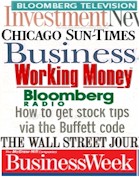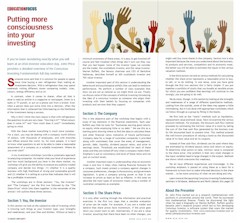|
Someone once said
that it is common for people to spend more time
buying a new refrigerator than making an investment
decision. With a refrigerator they may spend weekends
visiting different stores comparing models, sizes,
colours, energy efficiency and so on.
In contrast, when
it comes to shares, often all that is done is read
an article in a magazine or newspaper, listen to
a radio or TV pundit, or act on a phone call from
a broker. Even when a person does put extra time
into a decision, often the information that is collected
has little bearing on the likelihood of the investment
being a success.
Why is this? I think
the main reason is that with refrigerators the questions
to ask are very clear. “How big is it?”
“What colours does it come in?” and
“How much does it cost?” immediately
spring to mind. With the share market everything
is much more complex. |
|
For a start, you may be
dealing with a company worth billions of dollars, with
thousands of employees, and with branches and offices
around the world. So, for most people, it is hard to know
what questions to ask to be able to make a reasonable
assessment of a company as a suitable investment. Where
do you even start?
Through Conscious Investor
and in my investment workshops I provide a systematic
approach to analysing companies. No matter what your level
of experience and how much background you have in the
share market, my workshop will give you the ability to
analyse any publicly-traded company and decide two things:
(1) whether it is a quality business with high likelihood
of strong and sustainable growth and (2) whether it is
selling at a price that indicates that it will be a profitable
investment.
The workshops are in three
sections: “You, the Investor” and “The
Company” are the first two followed by the “The
Share Price” which links them together. In the remainder
of the article I will outline these three sections.
Section 1: You,
the Investor
In this section we look
at the subjective side of investing which is knowing such
things as your investor type, your strengths and weaknesses,
and your likes and dislikes.
Without at least a minimum
awareness of these areas, it is easy to get knocked off
course and feel troubled when things don’t turn
out they way that you had hoped. Some of the investor
types we consider are the trader, the scuttlebutt investor,
and the value investor. Warren Buffett, the famous chairman
and CEO of Berkshire Hathaway, describes himself as 30%
scuttlebutt investor and 70% value investor.
Another important part of
this section is understanding the behavioural and psychological
pitfalls that can lead to mediocre performance. We perform
a number of class examples that show we are not as rational
as we might think we are.
Finally we discuss some
of the concepts of ethical investing introducing the idea
of a conscious investor as someone who aligns their investing
with their beliefs by focusing on companies with products
and services that they support.
Section 2: The Company
This is the objective part
of the workshop that begins with a study of key elements
in the financial statements. Each year Buffett says that
he looks for “businesses earning good returns on
equity while employing little or no debt.”
We use this as a starting
point showing where to find the data to calculate these
and other financial ratios indicative of future performance.
Company data for a range of Australian companies is provided
along with worksheets that cover the areas of management,
growth, debt, liquidity, dividend payout ratios, and price
to earnings ratios. Thresholds are established for each
of these areas and they are ticked off only when a company
meets them. Emphasis is put on consistency and level of
these ratios and not just on current levels.
Another important topic
is understanding what an economic moat is and how it helps
when making financial forecasts for a company. Such moats
protect a company against changes in consumer preferences,
changes in the economy, and government legislation. It
gives a company pricing power so that it can increase
its prices as least as fast as inflation. In this area
we describe the main types of economic moats using a number
of Australian companies as examples.
Section 3: The Share
Price
It is only after working
through the information and practical exercises in the
first two steps that a sensible evaluation of price can
be made. For example, if you are a trader and believe
that share prices have momentum, if the price goes down
you would want to sell.
Alternatively, if you are
a value investor, assuming that there have been no other
changes, you might well buy more shares in the company.
Section two is also important because the more you understand
about the business, its products and services, competitors
and its economic moat, the better you will be able to
estimate the inputs in the various valuation methods.
In the third section we look at various methods for calculating
whether the share price represents a reasonable price
to buy, to sell, or to do nothing.
In one sense, once you have
gone through the first two sections this is fairly simple:
if you put together a portfolio of stocks that you bought
at sensible prices for which you are confident that earnings
will continue to rise strongly, you are going to do well.
We do more, though, in this section by looking at the
strengths and weaknesses of a range of different quantitative
methods. Looking from the outside, some of the ideas may
appear a little intimidating. But it is all done with
appropriate worksheets which we follow through as a group
by filling in the blanks.
We first look at the “static”
methods such as liquidation, replacement value and book
value. Next we examine the various discount methods. For
example, the discount cash flow method proceeds by estimating
the intrinsic value of a stock by taking the sum of the
free cash flow generated by the business over its life
discounted back to present time.
This method extends the
well-known procedure of valuing a bond as the discounted
value of its face value and all its coupons. Instead of
free cash flow, dividends can be used where they are estimated
by dividend payout ratios and return on equity. To determine
what action to take, intrinsic value is compared to the
share price. One problem is that very small changes in
the input variables lead to large changes in the output.
Methods are shown which overcome this weakness.
We all have different experiences
and knowledge. In the workshop emphasis is placed on using
these as a basis for a framework to know how to make informed
decisions in the share market … to be more conscious
of what we are doing and why.




